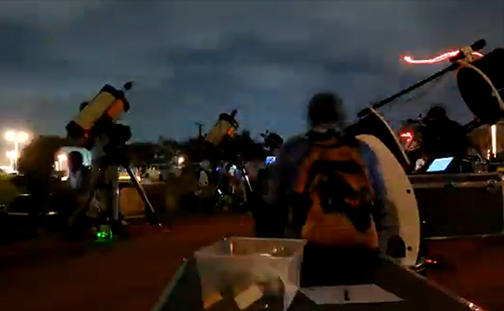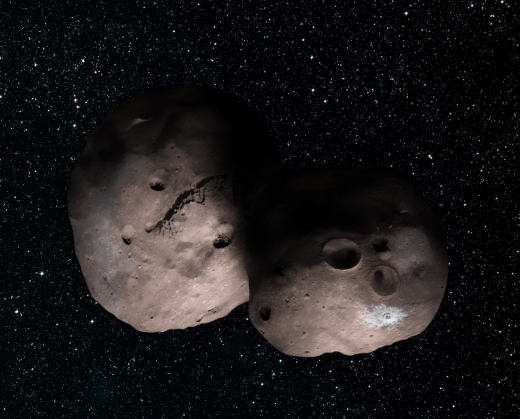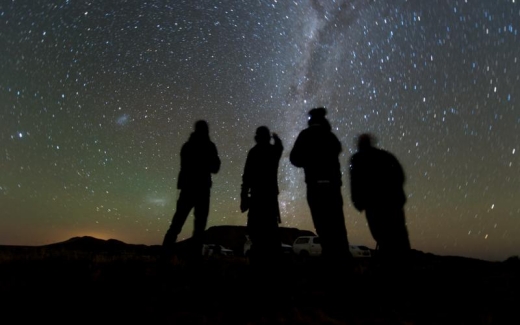I am now back on the job, and somewhere beyond Pluto seems a good place to go. Somehow it seems safer out there. While vacationing here on Earth, I was bitten by a brown recluse spider, spent two weeks with a swollen and painful foot, and came down with the most intense flu-like symptoms I’ve ever experienced. The final indignity: I received my monthly report on Centauri Dreams reader statistics. Since I had done no posting for a large portion of this report, I was curious to find out how much traffic had slowed in my absence. It turned out that traffic increased right after I stopped posting and stayed robust the entire time.
I am trying to figure out what this means…
But back to New Horizons, putting my tumultuous vacation experience behind me. Anyone who remembers how hard it was to find a suitable Kuiper Belt Object to serve as New Horizons’ next target will understand how challenging it would be to observe MU69 from the ground. The distant object, perhaps a binary, must be made to yield as many of its secrets as possible as our spacecraft continues the journey that will culminate in a New Year’s Day 2019 flyby. The effort proceeds by the observation of stellar occultations by hardworking mobile teams.

Image: Practicing for the August 2018 Senegal MU69 occultation. Credit: NASA/Johns Hopkins University Applied Physics Laboratory.
What good news, then, to hear from the New Horizons scientists that the latest effort to catch MU69 (recently dubbed ‘Ultima Thule’) passing in front of a much more distant star has been successful. An earlier effort took scientists to Argentina and South Africa in June of last year, while in July of 2017 the NASA Stratospheric Observatory for Infrared Astronomy (SOFIA) probed the area around the object for debris that could pose a collision hazard to the spacecraft. The Hubble instrument also examined the region that same month.
But it’s the ground-based effort that fascinates me. Because when I think of eclipses, I think about large bodies like the Moon passing in front of the Sun, or Earth’s shadow darkening the Moon. Yet the New Horizons effort is likewise the attempt to track an eclipse, one so demanding that it takes pinpoint geographical precision and sheer luck to pull in the data. The strips of shadow cast by MU69 were no more than 30 kilometers wide, with the teams’ telescopes placed at multiple points to catch the moment when the KBO passed in front of the star. Almost 50 researchers made the trip to Senegal and Colombia for the event.
The earlier occultations yielded measurements indicating that MU69 is an ‘extreme prolate spheroid,’ meaning an object shaped something like an American football. A close binary or even a ‘contact’ binary can’t be ruled out, with two objects actually touching each other.

Image: This is one artist’s concept of Kuiper Belt object 2014 MU69, the next flyby target for NASA’s New Horizons mission. This binary concept is based on telescope observations made at Patagonia, Argentina, on July 17, 2017, when MU69 passed in front of a star. New Horizons scientists theorize that it could be a single body with a large chunk taken out of it, or two bodies that are close together or even touching. Credit: NASA/Johns Hopkins University Applied Physics Laboratory/Southwest Research Institute/Alex Parker.
We now turn toward weeks of analysis of the data gathered in Senegal and Colombia on August 3-4. Weather was an issue in the new work just as it was at the team’s multiple sites in Patagonia in 2017.
“Gathering occultation data is an incredibly difficult task,” said New Horizons occultation event leader Marc Buie of the Southwest Research Institute, Boulder, Colorado, who also discovered Ultima Thule about a year before New Horizons flew past Pluto in July 2015. “We are literally at the limit of what we can detect with Hubble and the amount of computer processing needed to resolve the data is staggering.”

Image: A photo from the previous occultations. Four members of the observation team scan the sky while waiting for the start of the 2014 MU69 occultation, early on the morning of June 3, 2017. The target field was in the Milky Way, seen here from their observation site in the Karoo desert near Vosburg, South Africa. They used portable telescopes in an attempt to observe MU69, a small Kuiper Belt object (now nicknamed Ultima Thule) and the next flyby target the New Horizons spacecraft, pass in front of a star. New Horizons team members made similar observations of Ultima this week in Senegal. Credit: NASA/Johns Hopkins Applied Physics Laboratory/Southwest Research Institute/Southwest Research Institute/Henry Throop.
The spacecraft itself continues to receive commands from Earth in preparation for the Ultima Thule flyby, including memory updates, as subsystem and science instruments are checked out. In September, New Horizons will begin to make observations of the target, which will once again help to refine the spacecraft’s course for the flyby. The distance between spacecraft and KBO for the event is now planned to be 3,500 kilometers. When it occurs, at 6.5 billion kilometers from Earth, tiny Ultima Thule will become the most distant object ever explored.



A vacation to be quickly forgotten!!
Although given your new insights into the readership bonus, maybe time for a second go!!
^_^
Just kidding!!!
Yes, unusual readership insights came with the vacation!
what it means is: get bitten by brown recluse spider.
Once is enough, though. I can only hope, never again.
“The final indignity: I received my monthly report on Centauri Dreams reader statistics… It turned out that traffic increased right after I stopped posting and stayed robust the entire time.
I am trying to figure out what this means”
While the cat’s away the mice shall play.
As for spiders I was once biten by what looked like a funnel web spider, awful experience. This is one ceature we must leave behind as we colonize the solar system!
Glad to have you back Paul.
Yes, I hadn’t realized just how nasty a bite from the wrong kind of spider can be. It took days and days to build up and then really socked me. Much improved now, though.
If no skin graft needed, that’s a good outcome with a brown recluse. Arachnid are mostly predators and some have evolved horrific chemical weapons.
No graft needed at this point. And a lesson learned: Always check your shoes before putting your feet in them!
Re traffic: once you get used to reading something new here every 1-2 days, when that flow of articles dries up you feel its lack more keenly. If I just read something on your site in the morning, then that particular mental itch is satisfied and when my browser finger gets itchy in the afternoon I’m not going to be hitting that part of my bookmarks list again. Having read nothing here for many days, though, the feeling that something is overdue accumulates, and knowing in my brain that the blog is on hiatus does no more good for my gut (which apparently has control over my itchy browser finger) than knowing the power is out prevents me from trying to flick the light switch on during an outage. So I think it means you have regular readers who like to keep the flow of articles at its habitual pace, and who get anxious (beyond what reason would dictate) when the flow dries up.
What a wonderful way to interpret my stats. I’ll keep that view in mind.
Some of us were aware of that need and during Pauls vacation we added news items in the penultimate comments section to help tide the time for those who like you reflexively came here. ;)
I have to agree with jonW, I kept finding myself checking back here. Face it, we missed you. Glad you’re back and recovered.
Thanks, Daniel! Feeling much better now.
This is the same hypothesis that I came up with.
Glad you got over the spider bite
Paul!
Michael
Thank you, Michael T!
For someone like me who thinks that Facebook little hand has the wrong finger up and that there’s a reason why TWITter is spelled the way it is, this site, that uses neither, represent a little oasis of calm and rationality in a crass and noisy internet.
It doesn’t surprise me that traffic has increased!
What a kind thing to say, Enzo. Many thanks!
Yes! And uhh..”like”
Don’t be fooled by the stats Paul. You were much missed. I checked every day hoping you couldn’t resist an extra article or two. I’m still mulling over the habitable zone work which added a great deal to my knowledge of such things. Your article contributors are truly amazing.
Thank you, Gary. Glad the habitable zone work was useful. More of this ahead!
While I have to say that the idea that you should go to someplace beyond the planet Pluto seems to be a little bit of an extreme reaction to being bit by a brown recluse spider, I have to admit that I’ve never been bit by such a spider, so I don’t know exactly, whether or not that might be a justified destination or not. Perhaps it is.
Putting that aside, however, whether or not there may be spiders on Pluto (which I assume might be gigantic in size because of the lesser gravity) and possibly have antifreeze for their blood, I have to say that the accomplishment of an occultation of some distant star is a considerable feat.
What interests me about this is the question about whether or not one would have to know something about the dimensions or what might be the equivalent, surface brightness (so to speak) of the target star itself, such that you could accurately determine the shape of the asteroid itself. Another factor which I wonder about is the velocity of the asteroid and how it’s uncertainty might impact the dimensionality of the body itself. How can they know how accurate the velocity of the asteroid body is ? Usually determinations of unknown bodies from what I’ve read indicates that you must make multiple observations over a bit of extended period of time to nail down just what the velocity should be when you observe it as it passes in front of the target star. Does anyone know the answer to that question? And does surface brightness and size of the target star play any part in being able to nail down the dimensions of the asteroid?
All good questions, though I have no immediate answers. I’ll post if I find something helpful.
Firstly, orbital dynamics for Ultima Thule are determined through Hubble and ground based images of the faint dot and are refined over time. Secondly, the star and it’s properties are irrelevant because the occultation yeilds a shape and size profile primarily and also helps to refine the orbit once you know where the shadow was (trigonometry)… by setting up a bunch of telescopes in a long line (preferably longer than the shadows width so the endmost telescopes record no occultation) each observer times the shadow duration and from many measurements an accurate shape can be drawn on a map of the outline of the shadow.
Here is a a fantastic set of details with those results in pictures I tried to describe above (worth a thousand words…)
http://www.planetary.org/blogs/emily-lakdawalla/2018/0124-new-horizons-prepares-for-2014mu69.html
(And the two preceding blog posts for juicy info…)
http://www.planetary.org/blogs/guest-blogs/2017/20160616-mu69-occulation-campaign.html
http://www.planetary.org/blogs/emily-lakdawalla/2017/0720-total-eclipse-of-a-star-mu69.html
Hi Paul ..
Welcome back ..
Sorry about the spider bite ..
I utilized your down time to re-read some
topics of interest from your archives ..
Any chance that you have a list of “most commented” topics ??
Triff ..
Triff, I’m not sure if I can figure out how to generate such a list. But I can ask some of the software gurus in my acquaintance, and will let you know if I learn how to do it.
A brute force method is to crawl through all the posts and extract the number of comments for each. If you cannot find a better solution, I might be able to write some code to generate that list for you.
Thanks, Alex. Let me see if there isn’t already a plugin to do something like this, but if not, I may come back to you re that offer.
An automated search for this string
{ 32 comments… add one }
with the number linked to the title and added to a dataset may be helpful.
Yes, excellent idea!
Sadly, I’m guessing this is not the kind of spider bite that confers super powers?
Good to have you back at work!
My super powers have not yet begun to operate. I wonder how long it takes?
Would an airborne platform (e.g. a 747 with a telescope) work for studying these stellar occlusions? With so many KBO and asteroids present, would a project to set up a dedicated airborne occlusion-chasing platform yield significant scientific return (at astronomical cost)? Hundreds of KBO could be studied per year.
Yes it would work… infact SOFIA was flown to assist in last summers occultation measurements.
Hi Paul,
I know how you feel (or felt), but at least you didnt get bitten by THESE spiders!
https://en.wikipedia.org/wiki/Children_of_Time_(novel)
Welcome back
P
Yipes!
Welcome back Paul, I really missed your daily updates! The best thing about your site is apparent simplicity with no ads, no pop-ups, simple plain white background with no fancy stuff. It is a very welcoming site and reminds me of the Google search page and why it was so better than Yahoo search, MSN search, Alta Vista, AOL etc.
Thanks for the comment. I do try to keep all the popups and other annoyances off the site, as they drive me crazy when I encounter them elsewhere. Glad you like the look.
There were 5 candidate objects found by HST in the search for a New Horizons target, 2 of these (besides Ultima Thule) having successful followup HST observations. These objects are I believe the only objects known in their size class in the trans-Neptune population. They cannot be imaged from the ground, but if they are not observed they will be lost.
The Ultima Thule occultation results (plus the availability of Gaia DR2 data) show that these objects can be imaged (in projection) and orbits improved through occultation observations for the fraction of the cost of a spacecraft observation (including HST time). This suggestions that amateur occultation campaigns should be mounted to observe and track the other New Horizons targets, not just the one chosen for the flyby. Ultima Thule appears to be a contact binary; an obvious scientific goal would be to determine if the other candidates were too, and thus get some statistics on this condition in the small TNOs.
Sorry to hear about the brown recluse spider bite, my wife and a former supervisor where bitten by them. It’s not much fun and hope you are recovering well.
Much better, thank you. But it took a long time!
Great article; nice to see so much interest in the New Horizons KBO mission. I’ve one minor note though: the country is spelled `Colombia’ (two `o’s), not `Columbia’ like the Shuttle. Looking forward to future articles!
Right you are, and thanks for noticing that. I’ve made the change.